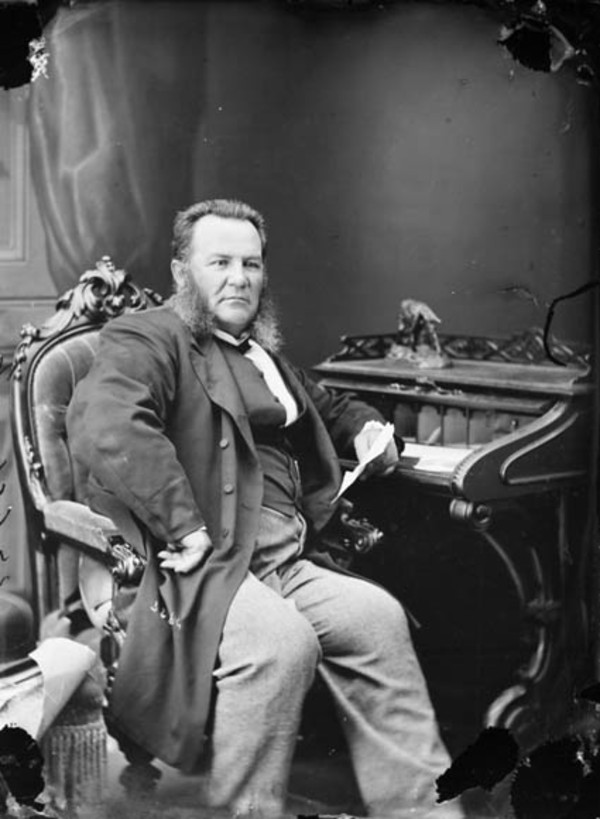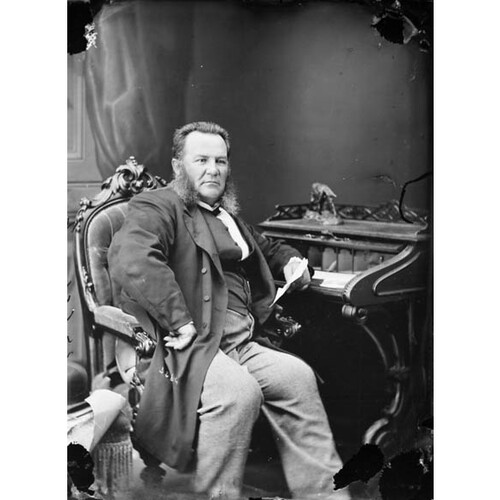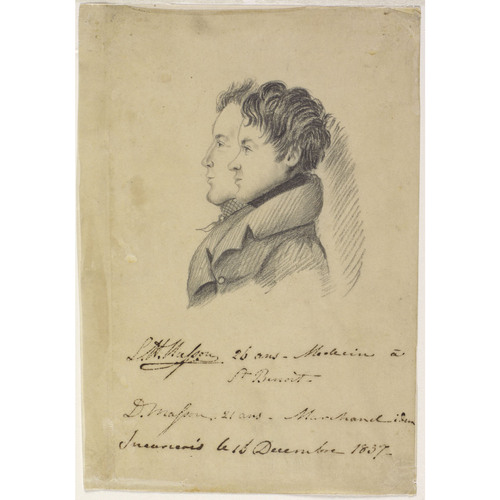MASSON, LUC-HYACINTHE, doctor, businessman, and politician; b. 16 Aug. 1811 at Saint-Benoit (Deux-Montagnes County), L.C., son of Louis Masson, tavern-keeper and militia captain, and of Marie-Louise Choquet; d. 18 Oct. 1880 at Coteau-Landing (Soulanges County) and buried 20 Oct. 1880 at Saint-Anicet, Que.
Luc-Hyacinthe Masson belonged to the fifth generation of an Orléans family that emigrated to Quebec in the middle of the 18th century. He learned the rudiments of grammar and mathematics while living at home in the little village of Saint-Benoît. He continued his education at the college of Montreal, then turned towards medicine, which he studied under Dr Robert Nelson. An arbitrary action of the government had made the youth susceptible to the political influence of the famous Dr Nelson: on 12 July 1827 his father had been relieved of his post as militia capatin for “Patriote activity.”
In the spring of 1832 the epidemic of Asiatic cholera that reached Lower Canada from Europe pushed major political and national questions into the background. Doctors were summoned to another kind of heroism than that of nationalist resistance. The young student went to the assistance of the immigrants of Pointe-Saint-Charles, replacing his master, who had just fallen ill; on 1 Aug. 1832, at Saint-Clément-de-Beauharnois, he took the place of Dr Charles Fleming, who had succumbed to the disease. Masson’s strong constitution enabled him to emerge unscathed from this arduous experience, and the following year, 1833, he qualified as a doctor. He practised first at Saint-Clément-de-Beauharnois, then in his native village of Saint-Benoît, where on 28 Jan. 1835 he bought a piece of land in Rue Saint-Jean-Baptiste.
At this time was formed the famous triumvirate of Jean-Joseph Girouard*, Jean-Olivier Chénier*, and Luc-Hyacinthe Masson, which formed the basis of the resistance of the north to the “Red Coats.” Luc-Hyacinthe Masson took part in all the meetings prior to the rebellion and showed himself to be a fiery orator. Lord Gosford [Acheson*] as a result annulled his commission as justice of the peace. From words the young doctor quickly passed to action, and became closely involved in the organization of resistance on “military” lines. Arrested on 16 Dec. 1837, the day after the defeat at Saint-Eustache, he was exiled to the Bermudas by the proclamation of Lord Durham [Lambton*] on 28 June 1838. Luc-Hyacinthe obtained permission to practise medicine during his months of exile.
The disavowal of Lord Durham’s proclamation by the British parliament allowed Luc-Hyacinthe Masson to leave the Bermudas. He entered the United States on 9 Nov. 1838. At Fort Covington, New York State, he opened a general store in partnership with his uncle, Eustache Masson, who, having been compromised and ruined by the rebellion, had resolved to take refuge in the United States with his family. The business was highly successful, and Luc-Hyacinthe married his uncle’s daughter Cécile (Célinie). But Eustache Masson died in 1840, and two years later Luc-Hyacinthe decided to return to Canada. His liking for trade prevailed over his liking for medicine, and, in partnership with his brother Damien, Luc-Hyacinthe Masson laid at Saint-Anicet the foundations of a general business under the name of Masson et Cie. Through his drive and spirit of initiative he stimulated the growth of the new village of Saint-Anicet.
In 1844 Luc-Hyacinthe became collector of customs in the port of Dundee, on the Canadian-American border. He also became involved in municipal politics as mayor of Coteau-Landing and in provincial politics as representative for Soulanges in the assembly of the Province of Canada from 31 July 1854 to 28 Nov. 1857. In parliament he completed the task to which he had given his energy since 1849: the obtaining of an indemnity for farmers on the two shores of Lac Saint-François for damage caused by floods resulting from the construction of piers at the head of the Beauharnois Canal. In 1860 he took up residence on the other side of the river, at Coteau-Landing, where he again devoted himself to business. After confederation, Luc-Hyacinthe Masson was the representative for Soulanges in the Canadian House of Commons from 3 Sept. 1867 to 8 July 1872. The fiery Patriote agitator of 1837 had become a fervent supporter of the Conservative party.
In 1872 Luc-Hyacinthe Masson returned to private life. He held the offices of registrar of the county of Soulanges and of clerk of the circuit court, with residence at Coteau-Landing. Having lost his wife on 3 May 1846, he had married on 12 June 1849 Odile (Élodie) Watier, daughter of Joachim Watier of Coteau-du-Lac. Of his six children, only two survived him.
At the southwest corner of the monument to the Patriotes of 1837–38, erected in the cemetery of Côte-des-Neiges at Montreal, the name of Luc-Hyacinthe Masson bears witness to the tragic moments of a sometimes troubled life. His reputation as a philanthropist when he died on 18 Oct. 1880 is a testimony of another kind, to a life always well lived.
AJM, Louis Richard, La famille Masson. AVM, B 2015. Archives paroissiales de Saint-Clément-de-Beauharnois (Beauharnois, Qué.), Registres des baptêmes, mariages et sépultures. Archives paroissiales de Saint-Ignace (Coteau-du-Lac, Qué.), Registres des baptêmes, mariages et sépultures. Archives paroissiales de Saint-Zotique (Coteau-Landing, Qué.), Registres des baptêmes, mariages et sépultures. ANQ, Jean-Joseph Girouard, Papiers personnels et lettres reçues, 17 août 1751; Ludger Duvernay, nos.292, 391; QBC, Procureur général, Événements de 1837–1838, nos.598, 669, 770, 803, 805, 845, 869, 3182, 4106, 4145. PAC, MG 30, D62 (Audet papers), 20, p.450. “Le journal de l’abbé N.-J. Ritchot, 1870,” G. F. G. Stanley, édit., RHAF, XVII (1963–64), 537–64. “Les Patriotes aux Bermudes en 1838, lettres d’exil,” Yvon Thériault, édit., RHAF, XVI (1962–63), 438; XVII (1963–64), 424–32. La Minerve (Montréal), 18 oct., 19 oct. 1880. L’Opinion publique (Montréal), 19 avril 1877. Can. directory of parliament (Johnson), 358. Can. part. comp., 1872. Desjardins, Guide parle mentaire. Raymond Masson, Généalogie des families de Terrebonne (4v., Montréal, 1930–31). R.-L. Séguin, “Biographie d’un patriote de ’37, le Dr Luc-Hyacinthe Masson (1811–1880),” RHAF, III (1949–50), 349–66.
Cite This Article
Andrée Désilets, “MASSON, LUC-HYACINTHE,” in Dictionary of Canadian Biography, vol. 10, University of Toronto/Université Laval, 2003–, accessed April 2, 2025, https://www.biographi.ca/en/bio/masson_luc_hyacinthe_10E.html.
The citation above shows the format for footnotes and endnotes according to the Chicago manual of style (16th edition). Information to be used in other citation formats:
| Permalink: | https://www.biographi.ca/en/bio/masson_luc_hyacinthe_10E.html |
| Author of Article: | Andrée Désilets |
| Title of Article: | MASSON, LUC-HYACINTHE |
| Publication Name: | Dictionary of Canadian Biography, vol. 10 |
| Publisher: | University of Toronto/Université Laval |
| Year of revision: | 1972 |
| Access Date: | April 2, 2025 |





